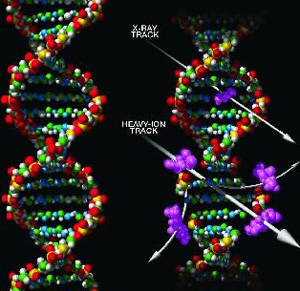Science
 |
|
On the left is an artist’s concept of a DNA molecule. At the upper right, an X-ray breaks apart the DNA. The damage from an X-ray is much less than the damage from a cosmic ray heavy ion. (NASA) |
Because of their high speeds and their small size, most cosmic rays go right through the body. Some, however, can hit atoms in the body.
Of these cosmic rays, a few may randomly hit the DNA in a cell. (Cells are the tiny units that make up biological life. DNA is a molecule that controls how the cell works.) If a cosmic ray damages the DNA, the cell will most likely die. Sometimes, though, the cell will malfunction. If enough cells malfunction, the nervous and immune systems may be affected. The astronaut will also have a greater chance of getting cancer later in life.
On very short missions to outer space, like a two-week trip to the Moon, cosmic rays are not dangerous. On missions lasting more than half a year, like staying on the Moon or flying to Mars, cosmic rays can be dangerous to astronauts.
Scientists have a poor understanding of how cosmic rays might affect the human body on long space missions. NASA's goal, however, is to protect astronauts. That is why we built the Cosmic Ray Telescope for the Effects of Radiation (CRaTER). CRaTER measures how cosmic rays impact human tissue.
 |
“Now I feel bad about being a cosmic ray. Let’s leave this page. |
